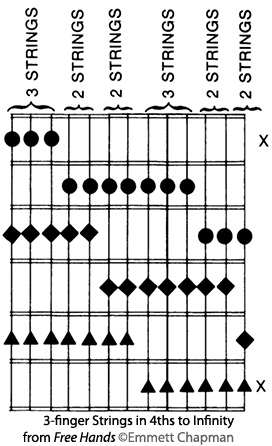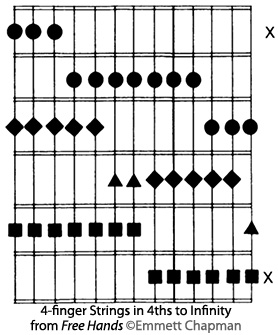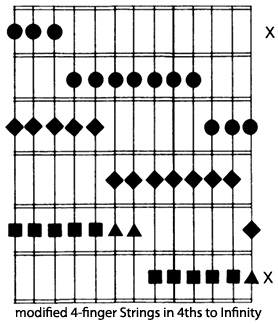Method Articles
A Hot Poppin' 7/4
By Emmett Chapman, posted July 4th, 2008
© Emmett Chapman 2008 |
 |
 |
The 4th of July title of this message" alludes to:
Starting at the beginning, the guitarist's left fingering hand is engaged in something very old. Why does it feel so right? The ancient practice arose out of a very favorable confluence of three seemingly unrelated factors:
1) The audible range of the human ear.
2) Guitar type scale lengths of vibrating strings producing notes within this audible range, and the resultant mathematical layout of frets along an underlying fingerboard.
3) The size of the human hand and the spacing of the fingers that fit so well into those frets.
Just think, if the laws of physics and human anatomy had been off by just a bit, there'd be no such confluence and we'd all be beating drums and blowing horns (not a bad alternative).
As it is, we were designed with a special propensity to play on strings, but we were also dealt a "wild card" in this Garden of All Good Things, that is, a strange paralysis between 3rd and 4th fingers. It's OK for the guitarist who can somehow get those fingers to "stop" the strings ahead of RH execution, and who can play difficult passages by sheer will power, mustering those outer digits to their proper locations in time for exact and forceful RH articulation.
The Stickist must execute with the fingering hand, keyboardists too, no easy feat. As Keith Jarrett once said in a magazine interview, to be creative one must attack the keys with "ferocity".
So what about this new generation of electric and sometimes acoustic fretboard tapping musicians on all manner of Stick, guitar and bass instruments? They're caught between keyboard and guitar with advantages from both. Like a keyboardist their fingering hand must be on time, and both hands engage in the same technique both independently and interdependently. Like a guitarist they can sustain a note as long as they want just with the hands alone, all the while manipulating that note for its duration in a variety of expressive techniques.
Back to the "wild card", which I see as the built in limitation in "wiring" between the 3rd and 4th finger, the common larger nerve that retards individual movement. Why oh why weren't we designed with the true super-hand, one with independent motor control equally among the fingers? We didn't need it? We weren't supposed to be guitar players?
There is a clue! The pinky is also substantially smaller than the others. Is it a remnant or might it be growing in function over evolutionary time? Its fate may be determined by influential individuals who "express the wish" (Bob where are you now?).
OK, I've set up the guitar player's dilemma, especially relevant for eight fingered activation of Stick and FTIs. Is there a way out? You knew there would be! Why else would I write this? Fortunately we were also designed with a marvelous brain that can in turn design anything else, recreate reality, defy the "human condition" and take us out of our boxes whenever need be.
The 4th finger has reach and span (and BTW so does the baby toe). On some hands this spread is greatest of all the fingers. It would be a shame to lose that span which fits so nicely into the mid ranges of the fretboard. This four-finger span allows the drumming of fingers at one location on the board, a valuable tool to compliment the graceful flow of hands at all angles over the entire board that takes you through "gestures" of melodic ideas, themes and variations.
As Greg teaches, the physical motions are in the hands, arms, elbows and shoulders to empower and express each note, the gesture itself communicating the intervals between the notes - a virtual sign language. But what about those fast rhythmic flurries contained within an idea? In sign language, when you sign a name or a place, you spell it out and suddenly your hand rhythm changes, the hands speeding up and the fingers forming complex shapes. This is analogous to drumming your four fingers at a single region of the board to create a high speed, miniature "fractal" of your ongoing lead line.
Back to the "dilemma" at hand, a lack of independence between 3rd and 4th fingers weighed against the advantageous reach of the 4th finger. My "way out" is of course conceptual - my refuge of complete freedom. So here's what I've developed for RH melody:
It will all eventually flow smoothly as long as you add one last flick of the wrist into the equation. You see, 4-fingered melody takes your RH about 10 degrees beyond right angles to the strings, the wrist and forearm twisting to compensate for the shorter pinky (a possible cure for right shoulder hunch, BTW). Since five of the seven strings involved in the "Infinity" pattern are now played with the pinky substituting for the ring finger, you only need to flick the wrist to the more perpendicular hand orientation at the whole step/half step "snag" pattern, as your melody line crosses that pair of strings.
There you have it, a concept that flows smoothly and feels good after a while. I arrived at it relatively late in life and in a roundabout way, but now I use it a lot. Why does it work? It exploits the very weakness in our "wiring" design. On the head to toe neuromapping of the brain, is it one finger or two? My approach is to consider it conceptually as one finger, that is, whatever one will get you there.
I suspect there are some fluent guitarists out there (Allan Holdsworth comes to mind) who use this approach or a close version thereof, perhaps without even realizing it or having codified it. For better or for worse, I like to codify everything I encounter.
Happy July 4th, Emmett.